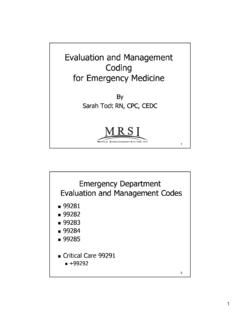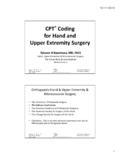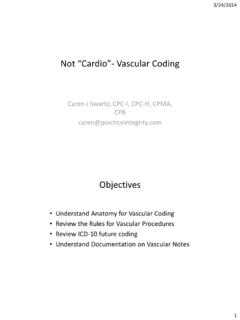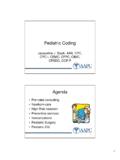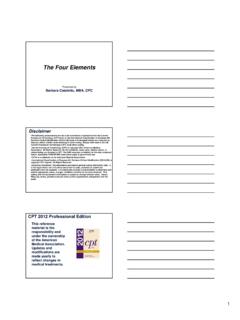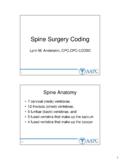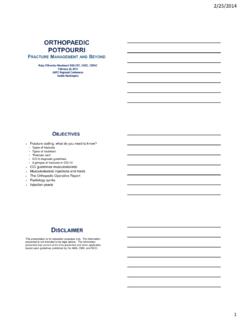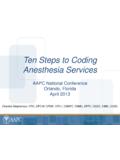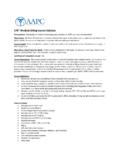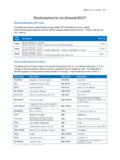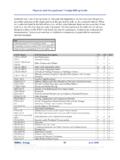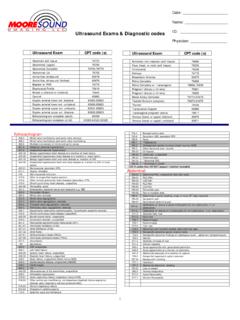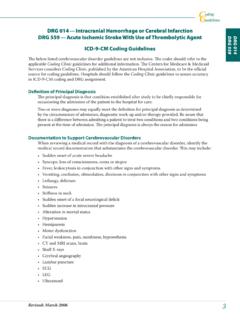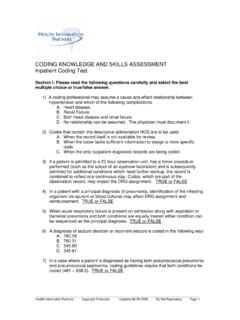Transcription of 2F-Documentation for HCC Codes-REVISED FROM …
1 1 HCC CODINGA documentation StrategyLynn Myers MD, CPC, CHCA genda Terminology History of Medicare Risk Adjustment Coding Strategy documentation Strategy22 Terminology HCC-Hierarchical Condition Categories-usuallychronic conditions used to create a risk adjustment methodology Rx HCC- Some HCC codes adjust risk due to prescription burden of disease CMS-Centers for Medicare & Medicaid Services Medicare Advantage (Managed Medicare)-A method of helping CMS budget for the cost of caring for populations of patients RAF-Risk Adjustment Factor-assessing the acuity of illness based upon reported ICD-9 codes & demographics, which ultimately is reflected in reimbursement-HCC codes are payment multipliers. (Average RAF is .01 increase in RAF results in 1% higher reimbursement to the Medicare Advantage company from CMS)3 History of Risk Adjustment In 1997, beneficiaries could choose between traditional and managed Medicare Managed Medicare companies are given a fixed dollar amount per enrollee from CMS Enrollees may enjoy additional benefits with the managed Medicare companies Physicians may enjoy better revenue than with traditional Medicare Since 2007, the managed Medicare companies receive payments based upon the HCC diagnoses assigned to each enrollee, plus a demographic factor-this is the Risk Adjustment Factor There are over 3000 diagnosis codes in about 90 categories, and each carries a value 43A Long Term Strategy Payments are based upon acuity of diagnosis.
2 Sicker patients will require more health care resources. The managed care plans depend upon accurate diagnoses that will ensure the appropriate dollars are available to care for each enrollee. Diagnoses must be reestablished each year to ensure that next year s payments will cover costs. For example, an amputation must be reported at least once per year to ensure that services related to this condition will be covered. documentation must support the diagnoses that are reported AND A PLAN FOR EACH DIAGNOSIS. Physicians get familiar with patients over time and neglect documentation of chronic stable Strategy ICD-9 Codes paint the picture and drive risk scores Risk scores drive the reimbursement from CMS to Managed Medicare Plans All diagnoses must occur as a result of face to face encounter Services rendered by physician.
3 NP or PA4 Coding Strategy code all documented conditions that co-exist at the time of the encounter that require Patient care Treatment Management Do not code conditions that were previously treated and no longer existCombinations in Coding A combination code is a single code used to classify Two diagnoses A diagnosis with an associated secondary process A diagnosis with an associated complication Identified by referring to sub-term entries in the Alphabetic Index and by reading the inclusion and exclusion notes in the Tabular List Assign only the combination code when that code fully identifies the diagnostic condition involved. Secondary codes may be necessary5 Signs & Symptoms Acceptable to code when a definitive diagnosis has not been established (usually do not risk adjust) Not acceptable when they are integral to the disease process Associated signs and symptoms that are not integral to a disease process should be coded Most found in Rule out or Possible are not valid diagnosesHypertension CodingHCC Categories 80, 131 Fourth digit indicates malignant ( ) or benign ( ), and unless documented with these terms must code (Unspecified)
4 BenignHTN is essential hypertension, usually chronic, asymptomatic and without target organ damage MalignantHTN is an accelerated hypertensive disorder, with diastolic BP usually >140 and accompanied by encephalopathy, nephropathy, retinopathy, heart failure or myocardial ischemia Controlled or Uncontrolled? Indicates clinical response to treatment, but does not differentiate between benign and malignant type Elevated blood Pressure does not code to hypertension-use is HTN related to Heart and Kidney Disease? Elevated BP increases pressure in the blood vessels, causing thickening over time. As the heart pumps against this pressure, it must work harder. This increased work causes the heart muscle to thicken, eventually leading to congestive heart failure if not treated. The thicker heart muscle needs more oxygen, and insufficient oxygen can lead to ischemia (angina) Thickening of the blood vessels may worsen atherosclerosis.
5 This is most damaging to the smallest blood vessels, such as in the heart and kidney, leading to damage of these end organsSystolic & Diastolic Heart Failure Systolic HF- a pumping problem caused by the ventricle losing its ability to contract normally because the heart muscle has become weak Diastolic HF is the result of a filling problem, caused by the ventricle losing its ability to relax normally because the heart muscle has become stiff. The heart can t fill with enough blood resulting in too little blood being pumped back out into the body Most patients have a combination of both; usually classified as whichever is worst7 HTN & Heart Disease documentation must state a causal ( due to or secondary to ), or implied (using the adjective Hypertensive ) relationship between HTN and Heart Disease it is not assumed Hypertensive CHF & Hypertensive HF & HTN due to CHF & HF due to HTN & Dual code requirement of and Heart Disease code .
6 More than one code from category 428 may be assigned 13 HTN LINKED HEART DISEASE w/CHF REQUIRES TWO CODES-ONE EACH FROM HTN HEART DZ AND CHFHCCCHF HEART FAILURE HEART DISEASE (HCVD)RX ONLYBENIGN W/O ONLYUNSPEC HTN W/O ONLYMALIGNANT W/O **BENIGN **UNSPEC HTN **MALIGNANT Kidney Disease (CKD)Four digits-the fourth indicates stage of 1&2 need additional evidence of kidney damage, such as urine protein that persists for 3 months or more, ultrasound or biopsyDocumentation must include stage, or is coded as CKD unspecified15 Dialysis Hemodialysis is the process of filtering the patients blood through a machine. Performed either as outpatient or inpatient Peritoneal dialysis uses the patient s abdominal lining to remove toxins. Usually performed in the patient s CKDS tageSeverityGFR ValueICD-9 codesStage 1 Some kidney damage with minimal or slight change in GFRGFR >90 ml/minWith kidney 2 Mild Kidney damageGFR 60-89 ml/min With kidney 3 Moderate Kidney damageGFR 30-59 4 Severe Kidney damageGFR 15-29 5 ICD-9 Stage5 Kidney FailureGFR < 15 chronic dialysis or NOS, Chronic Renal Failure orChronic Renal InsufficiencyChronic Kidney & CKD **REQUIRES TWO CODES-ONE FROM HTN DZ AND CKDRX ONLYBENIGN W/CKD (STAGE I-IV) W/CKD ONLYUNSPEC W/CKD (STAGE I-IV) W/CKD ONLYBEN W/O HF W/CKD ST W/O HF W/CKD ONLYUNSPEC W/O HF W/CKD ONLYMALIGNANT W/CKD (ST I-IV) W/O CHF W/CKD W/CKD KIDNEY DISEASE (CKD)
7 HCCCHRONIC STAGE 1 GFR> STAGE 2 GRF STAGE 3 GFR STAGE 4 GFR GFR < UNSPEC, DIALYSIS Coding Dual code requirement for patient on Renal Dialysis status ESRD on Hemodialysisdue to and HTN ( ) Relationship may be assumed between these conditions if both are reported Dual code required when 403 series is used, indicating the related CKD ( ) Hypertensive*CKD Stage 4 - & HTN & ESRD on dialysis (CKD Stage 6) & & *Even though coders may assume this relationship, coach providers to use the adjective form of the diagnosis2011 Hypertensive Heart & Kidney ( ) Both hypertensive kidney disease and hypertensive heart disease must be stated, although the relationship between hypertension and the CKD is assumed Any hypertensive heart disease is acceptable, not just HF 5thdigits are assigned 0 without HF and with CKD Stage 1-4 or unsp 1 with HF and with CKD Stage 1-4 or unsp 2 without HF and with CKD Stage 5 or ESRD 3with HF and with CKD Stage 5 or ESRD2122 HTN HEART DISEASE W/CHF & CKD**REQUIRES THREE CODES-ONE FROM HTN HEART DZ, CKD AND CHF Use add'l codeHCC**MAL W/HF W/CKD STAGE **MAL W/CHF W/CKD **BEN W/ HF W/CKD ST **BEN W/ HF W/CKD **UNSPEC **UNSPEC W/HF W/CKD KIDNEY DISEASE (CKD)
8 HCCCHRONIC STAGE 1 GFR> STAGE 2 GRF STAGE 3 GFR STAGE 4 GFR DIALYSIS STATE 5 GFR < UNSPEC, DIALYSIS LINKED HEART DISEASE w/CHF REQUIRES TWO CODES-ONE EACH FROM HTN HEART DZ AND CHFHCCCHF HEART FAILURE Diabetes is derived from a Greek word siphon , referring to passing through of water from the body, as diabetics tend to urinate excessively when sugar is not controlled Mellitus is derived from the Latin language and it refers to honeysweet , as in the high levels of sugar noted in blood and urine Insipidus is derived from the French language and refers to lacking of taste, or bland nature, probably due to nearly colorless urine noted in this condition23 Diabetes Coding HCC Categories 15, 16, 18, 19, 119 documentation of complications or manifestations must be stated ( due to or secondary to ), or implied (Diabetic) and are reported with 4thdigit Type I or II indicates type-Juvenile onset or Adult onset.
9 (Type is not dictated by use of insulin) If documentation indicates that the patient uses insulin routinely, append Sequence the 250 codes before the codes for the associated conditions Secondary diabetes coded to in Diabetes Coding 0 indicates Type 2 or unspecified, not stated as controlled or uncontrolled 1 indicates Type 1, not stated as controlled or uncontrolled 2 indicates type 2 or unspecified, uncontrolled 3 indicates type 1, uncontrolledAge is not a determining factor for type, though many develop Type 1 before reaching puberty, thus the term Juvenile Secondary Diabetes-Diabetes whose underlying cause is not genetics or environmental conditionsAccounts for 1-5% of total diabetes casesPresence of another underlying condition is major differentiating must know: Manifestation Control Underlying etiology2614 Causes of Secondary Diabetes Chronic pancreatitis Hemochromatosis Pancreatic disease due to cancer, trauma or other endocrine diseases Carcinoid tumors of lung, intestine or stomach Adrenal and pituitary tumors Celiac disease and other autoimmune diseases Removal of pancreas Orchiectomy-removal of testes for cancerDrugs and chemical agents: Diuretics and beta blockers Hormones Steroids Antipsychotics, lithium and antidepressants HIV drugs Seizure drugs Immunosuppressive drugs27 Diabetes Type 1 thought to be genetic, where the pancreas does not produce enough insulin.
10 This usually manifests at an early age, and usually requires insulin to manage, but not always Type 2 diabetes is caused by insulin resistance-insulin is produced, but the body does not respond properly. This usually (but not always) manifests in adulthood, may be managed with diet and exercise, but may require oral meds or insulin. It may have a genetic component in Diabetes Coding4 THDIGITMANIFESTATION0NO COMPLICATION1 KETOACIDOSIS2 HYPEROSMOLALITY3 COMA4 RENAL MANIFESTATIONS5 OPTHALMOLOGICAL 6 NEUROLOGICAL7 PERIPHERAL CIRCULATORY8 OTHER SPECIFIED9 UNSPECIFIEDMANIFESTATIONS29 Linking Words Linking words create relationship between diseases and manifestations Assures coders of a cause and effect between disease and manifestation, as we cannot assume (except in hypertensive renal disease) Appropriate terms.
